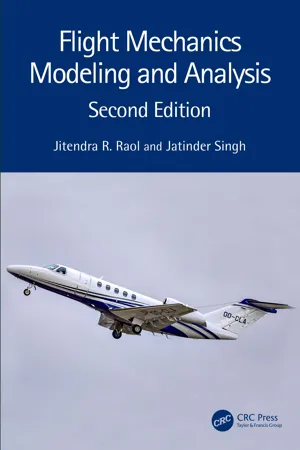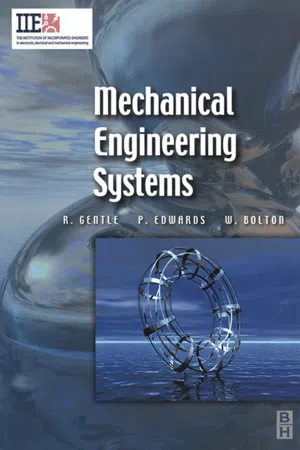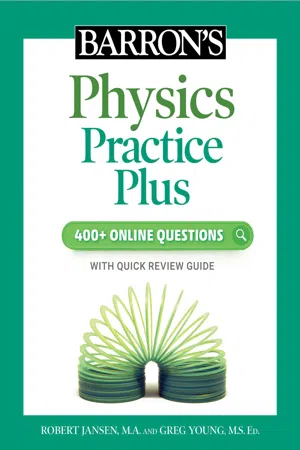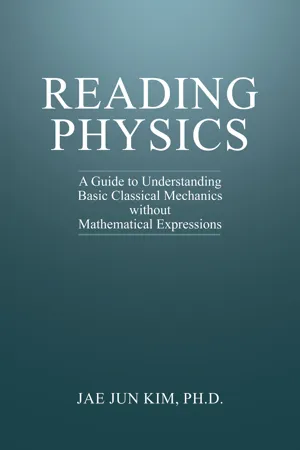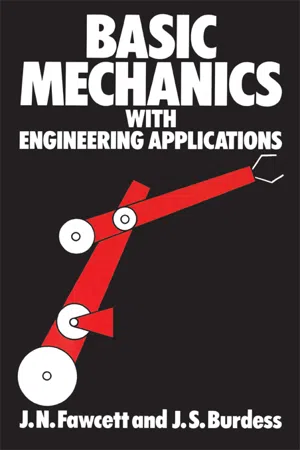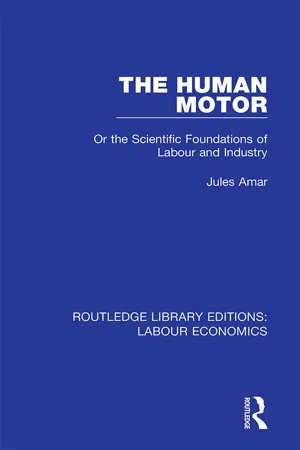Physics
Dynamics
Dynamics in physics refers to the study of forces and motion, particularly how objects move and interact with each other. It involves analyzing the causes of motion and the effects of forces on objects. Dynamics encompasses concepts such as acceleration, velocity, and the laws of motion formulated by Isaac Newton.
Written by Perlego with AI-assistance
Related key terms
9 Key excerpts on "Dynamics"
- eBook - ePub
Engineering Science
For Foundation Degree and Higher National
- Mike Tooley, Lloyd Dingle(Authors)
- 2013(Publication Date)
- Routledge(Publisher)
Part II Dynamics In this part of the book we consider the dynamic behaviour of bodies, that is, the motion of bodies under the action of forces. The study of Dynamics is normally split into two major fields, kinematics, the study of the motion of bodies without reference to the forces that cause the motion, and kinetics, where the motion of bodies is considered in relationship to the forces producing it. With the exception of the study of mechanisms in Chapter 9, we will not, in this short study of Dynamics, differentiate a great deal between these two areas, rather concentrating on the macroscopic effects of forces and resulting motions in dynamic engineering systems and machinery. We start our study of Dynamics in Chapter 8 by looking at a number of fundamental concepts concerning linear and angular motion and the forces that create such motion, including a review of Newton’s laws. We then consider momentum and inertia, together with the nature and effects of friction that acts on linear and angular motion machines and systems. Next, mechanical work and energy transfer are considered and their relationship to linear and angular motion systems is explored. Finally in Chapter 8, as a prelude to rotating machinery in Chapter 10, we take a brief look at circular motion and the forces created by such motion. In Chapter 9, we first consider the motion of one or two single and multilink mechanisms. In particular, we look at the nature of the relative velocities and accelerations of these mechanisms, together with the power and efficiencies of particular engineering machines that utilise such mechanisms. Then, very briefly, we consider the geometry and output motions of various types of cams. We will then look at a number of gyroscopic motion parameters, in particular gyroscopic rigidity, precession and reaction torque - eBook - ePub
- Jitendra R. Raol, Jatinder Singh(Authors)
- 2023(Publication Date)
- CRC Press(Publisher)
2 Engineering DynamicsDOI: 10.1201/9781003293514-32.1 Introduction
This chapter gives the reader an insight into the various aspects of engineering Dynamics. The subject of engineering Dynamics is a blend of physics, applied mathematics, basic logic, and computational methods. An airplane is considered as a dynamic system, and hence, many principles and concepts of engineering Dynamics are directly applicable to the study of aircraft flight mechanics–flight Dynamics. Important aspects here are the use of the tools that describe the motion and solve the equations of motion of the vehicle, wherein the kinematics of a particle or a rigid body supports the laws of Dynamics. The concerned scientists and engineers are interested in studying the movements of such bodies on Earth, in atmosphere, and in space and are also interested in predicting their behavior for longer time spans. Such an understanding would help them design, develop, modify, and use these vehicles for their intended purposes. The basic study actually starts with the vector mechanics algebra; however, it is presupposed to have been studied by the readers at the level of first two semesters’ course level in mathematics. The basic vector calculus can be easily used to derive the formulae for velocity and acceleration. The Newtonian mechanics plays very important role in the study of flight mechanics as dealt in Chapter 3 .The kinematical description can be understood by using either extrinsic or intrinsic coordinates: The former means that the description is extrinsic to the knowledge of the path followed by the point (rectangular Cartesian coordinates), and the latter means that the description uses the knowledge of the path. In the Cartesian coordinates, the position is known in terms of the distances measured along the three mutually orthogonal straight lines that represent reference directions. In the intrinsic coordinates, the unit vectors are defined in terms of the properties of the path, and these coordinates are known as path variables; alternatively, this description is also known as tangent and normal components. The fundamental variable for a denoted path is the arc length ‘s’ along a curve, measured from some starting point A to the point of interest, B. We also know that because ‘s’ changes with time, the position is an implicit function of time; this also means that the position is a vector function of the arc length. The velocity and acceleration are oriented parallel to the straight path. However, acceleration will not be parallel to the velocity for a smooth curvilinear path, unlesss ˙= 0 - eBook - ePub
- Richard Gentle, Peter Edwards, William Bolton(Authors)
- 2001(Publication Date)
- Newnes(Publisher)
4Dynamics
SummaryThis chapter deals with movement. In the first part the movement is considered without taking into account any forces. This is a subject called kinematics and it is important for analysing the motion of vehicles, missiles and engineering components which move backwards and forwards, by dealing with displacement, speed, velocity and acceleration. These quantities are defined when we look at uniform motion in a straight line. This subject is extended to look at the particular case of motion under the action of gravity, including trajectories. This chapter also looks at how the equations of motion in a straight line can be adapted to angular motion. Finally in the first half the subject of relative velocity is covered as this is very useful in understanding the movement of the individual components in rotating machinery.In the second part of this chapter we consider the situation where there is a resultant force or moment on a body and so it starts to move or rotate. This topic is known as Dynamics and the situation is described by Newton’s laws of motion. Once moving forces are involved, we need to look at the mechanical work that is being performed and so the chapter goes on to describe work, power and efficiency. Newton’s original work in this area of Dynamics was concerned with something called momentum and so this idea is also pursued here, covering the principle of conservation of momentum. The chapter extends Newton’s laws and the principle of conservation of momentum to rotary motion, and includes a brief description of d’Alembert’s principle which allows a dynamic problem to be converted into a static problem. - eBook - ePub
Stress, Strain, and Structural Dynamics
An Interactive Handbook of Formulas, Solutions, and MATLAB Toolboxes
- Bingen Yang(Author)
- 2005(Publication Date)
- Academic Press(Publisher)
Section 9.6 .9.2 Dynamics of Particles
9.2.1 PreliminariesUnits
Some commonly used quantities in engineering mechanics are listed in Table 9.2.1 , where units in both the Standard International (SI) and U.S. Customary Systems are shown.TABLE 9.2.1 UnitsNewton’s Laws
Classical mechanics was established based upon the following three laws of motion that were first stated by Isaac Newton in 1687:First Law: A particle remains at rest or moves with a constant velocity along a straight line if the sum of the forces acting on it is zero.Second Law: The rate of change of the linear momentum of a particle is equal to the sum of the forces acting on it.Third Law: The forces exerted by two particles upon each other, which are called the action and reaction forces, are equal in magnitude, opposite in direction, and collinear.Mathematically, Newton’s second law is expressed by(9.1)where m and ν are the mass and velocity of the particle, respectively; F is the resultant or sum of all forces acting on the particle; and mv is the linear momentum of the particle. If the mass m is constant, Eq. (9.1) becomes(9.2)where is the acceleration of the particle. Equation (9.2) is a commonly used expression of Newton’s second law, which indicates that the acceleration of a particle of constant mass is proportional to the resultant force.Besides Newton’s laws of motion, Newton’s law of gravitation is also important in Dynamics, especially in orbital Dynamics; see Sec. 9.2.6 .Force
The motion of a particle or body is caused by forces. A force is an action of pull or push applied by one body to another. A force is characterized by its magnitude, direction of action, and point of application. Thus, forces can be expressed by vectors, and superposition of forces follows the parallelogram rule of vector summation. For instance, the sum of forces F 1 and F 2 in Fig. 9.2.1(a) is obtained by the diagonal of the parallelogram formed by the forces, as shown in Fig. 9.2.1(b) - Robert Jansen, Greg Young(Authors)
- 2022(Publication Date)
- Barrons Educational Services(Publisher)
CHAPTER 5 DynamicsLearning Objectives In this chapter, you will learn:∘ Why objects with mass possess inertia and their natural state of motion is constant velocity∘ Why a force is a vector quantity that can be thought of as a push or a pull acting to change the motion of an object∘ The three laws of motion postulated by Sir Isaac Newton summarizing the interactions among objects, forces, and motion∘ How their influence on kinematics will be encountered in all areas of physics, developing universal problem-solving strategies for all Dynamics problems, an essential skillTable 5.1 lists the variables used in Dynamics.TABLE 5.1 Variables and Units for Forces in One DimensionInertiaInertia is the tendency of an object to resist changes in its natural motion. Galileo suggested that the natural state of motion of an object is constant velocity. Even an object at rest has a constant velocity of zero. Inertia is the tendency of a stationary object to remain at rest and for a moving object to continue moving at constant velocity. Inertia is a property of mass. The greater the mass of an object, the greater the inertia possessed by the object. Simply put, the more mass the object has, the harder it is to push around the object. Physicists regard mass as a quantity of inertia and a resistance to change in motion.ForceAn object cannot simply accelerate and change velocity on its own. In order to accelerate, an object must be pushed or pulled by some external source known as an agent. The push or pull of an agent that accelerates an object is known as a force. Forces are vector quantities measured in newtons.Since forces are vector quantities, they can be added together to find a resultant sum. The sum of all forces, , acting on an object is known as the net force. The direction of the net force is the same as the direction of the acceleration (change in velocity) of the object. The relationship between the direction of force and the direction of initial velocity of an object dictates the resulting change in motion, as shown in Table 5.2- eBook - ePub
Reading Physics
A Guide to Understanding Basic Classical Mechanics without Mathematical Expressions
- Jae J. Kim(Author)
- 2023(Publication Date)
- Universal Publishers(Publisher)
Day 26 Energy “Change in energy is defined as work done to or by a system. When an external force is applied to an object or objects, there is going to be a change in energy. Otherwise, the energy stays the same.”Pressure gains its meaning and importance only if the object on which the pressure is applied has dimensions. In other words, we cannot think of the quantity of pressure being used when the object happens to be a test particle, an entity that does not occupy any dimension. Think about this in terms of force and area.You may notice that the size of the arrows in the bottom of Figure 25.2 and Figure 25.3 are smaller than the ones on the top. Think about why it needs to be so and what type of force was covered in previous lessons to take them into account.It is hard to describe what energy is about, but we can think of it as the following: energy within a system does not go anywhere. No matter what that is, that does not change as a function of time and there it gains its importance.Kinematics is all about understanding a mechanical motion associated with an object or objects in a system. In essence, we want to be as specific as possible when describing the mechanical motion, thus we introduced some useful quantities such as velocity and acceleration. After that, we studied how they relate to each other. Problem: The physical quantity in kinematics does not get conserved. It changes. Think about velocity and acceleration for a moment. When something is thrown up in the air, does the size of the velocity and acceleration change or not?So, what do we do? What do we do to study something that may not change over time? Where do we study something like that?Answer: We study Dynamics, if not kinematics. However, understanding Dynamics is somewhat different from understanding kinematics. For instance, we study the cause by which a motion is being realized in Dynamics. Particularly, we introduced a quantity called “mass” to differentiate an object from others, and that led us to understand Dynamics better by studying what we understand as force.Is that the end of the story? No, it is not. We need to study at least one or maybe two more. They are energy and momentum in Dynamics. We are going to study energy first. It is going to be more interesting as we get into the topic further, but it could be a harder topic to deal with, so let us focus hard on this topic. - eBook - ePub
- J Jones, J Burdess, J Fawcett(Authors)
- 2012(Publication Date)
- Routledge(Publisher)
4DynamicsBasic Theory4.1 Dynamics of particles and rigid bodiesNewton’s Laws refer only to particles. We will therefore consider first the motion of a particle and later develop methods for dealing with the motion of rigid bodies. The approach is similar to that used in our study of kinematics where we started with the motion of a point, and then proceeded to consider rigid body motion.4.2 Dynamics of a particleThe motion of a particle under the action of applied forces obeys Newton’s Second Law. Hence, if we know the magnitudes and directions of the forces acting on a particle, its acceleration can be found. Conversely, if we know the acceleration of a particle from kinematic considerations, it is possible to find the total force acting on the particle.For a particle moving in a plane the general equation,F = mamay be expressed in components which are at right angles, e.g.where Fx , Fy and , are the components of F and a along the directions OX, OY of a Cartesian frame of reference.Example 4.1 Consider a particle P of mass m moving on a smooth horizontal table. Let the particle be restrained by a string which has one end fixed, so that the particle moves in a circular path of radius r, as shown in Fig. 4.1 . If ν, the magnitude of the velocity of the particle, is maintained constant, let us obtain an expression for the force in the string.In this case we can obtain the acceleration of the particle from kinematic considerations. A point moving in a circular path has an acceleration (see p. 16)In this case the magnitude of the velocity of the particle is constant so that = 0. The acceleration of the particle is therefore towards the centre of the path and its magnitudeWe now draw the free body diagram of the particle showing only the forces acting on the particle. Let us assume that there is a tension T in the string in the direction shown in Fig. 4.2 - eBook - ePub
The Human Motor
Or the Scientific Foundations of Labour and Industry
- Jules Amar(Author)
- 2018(Publication Date)
- Routledge(Publisher)
THE HUMAN MOTOR.
BOOK I.
GENERAL PRINCIPLES OF MECHANICS.CHAPTER I.
1. General.—A consideration of the general laws of mechanics is an indispensable preliminary to the study of any machine (animate or inanimate). It is only thus that the problems involved in equilibrium and movement can be properly appreciated.The subject of mechanics is generally divided under three heads:— 1. Kinetics. (The study of movement in itself). 2. Statics. (The study of the equilibrium of forces). 3. Dynamics. (The study of force in action).Such subdivision is both simple and logical. It does not exclude consideration of all the physical properties of the bodies under study. Mechanics in the practical department, to which the term “Applied Mechanics” is given, specifically takes account of all such properties, and especially of the deformation caused by the application of forces. It further deals with the strength of materials and the limiting stresses which solid bodies can sustain.A clear understanding of the mechanism of human activity is not possible without some general knowledge of the above laws. The writer has therefore thought it necessary to devote the earlier pages of this work to the subject of mechanics in general, both in order to give completeness to the discussion and also to save the reader the inconvenience of having frequently to refer to textbooks and other works of reference.2. (1). Kinetics.—When we see a body change its place, we say that it is moving and we imply that it has been stationary. In reality, all movement is relative and is reckoned by comparison of the body which moves, with another body, which serves as a datum. A man walking moves, relatively to the earth surface, the earth itself being in motion. The earth is moving relatively to the sun, while the sun also moves in space.Let the moving body be considered as a point. In moving, the point traces out a path which may be straight or curved. Its motion is either uniform or variable according as to whether the space passed over in equal intervals of time is the same or differs from time to time in its progress. - eBook - ePub
Lord Kelvin
An account of his scientific life and work
- Andrew Gray(Author)
- 2012(Publication Date)
- Perlego(Publisher)
Moreover, when a body is drawn or pushed by other bodies, it reacts on those bodies with an equal force, and this reaction is just as real as the action: its existence is due to the inertia of the body. The definition, from one point of view, is only a statement of the fact that the acceleration produced in a body in certain circumstances depends upon the body itself, as well as on the other bodies concerned, but from another it may be regarded as accounting for the reaction. The mass or inertia of the body is only such a number that, for different bodies in the same circumstances as to the action of other bodies in giving them acceleration, the product of the mass and the acceleration is the same for all. It is, however, a very important property of the body, for it is one factor of the quantum of kinetic energy which the body contributes to the energy of the system, in consequence of its motion relatively to the chosen axes of reference, which are taken as at rest. The relativity of motion is not emphasised so greatly in the Natural Philosophy as in some more modern treatises, but it is not overlooked; and whatever may be the view taken as to the importance of dwelling on such considerations in a treatise on Dynamics, there can be no doubt that the return to Newton was on the whole a salutary change of the manner of teaching the subject. The treatment of force in the first and second laws of motion is frankly causal. Force is there the cause of rate of change of momentum; and this view Professor Tait in his own writings has always combated, it must be admitted, in a very cogent manner. According to him, force is merely rate of change of momentum. Hence the forces in equations of motion are only expressions, the values of which as rates of change of momentum, are to be made explicit by the solution of such equations in terms of known quantities
Learn about this page
Index pages curate the most relevant extracts from our library of academic textbooks. They’ve been created using an in-house natural language model (NLM), each adding context and meaning to key research topics.

